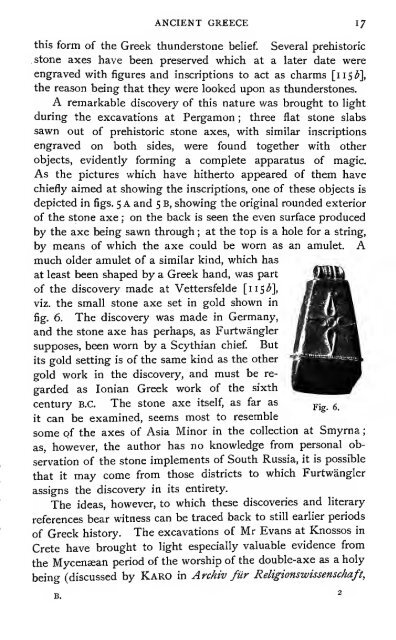The thunderweapon in religion and folklore, a study in comparative ...
The thunderweapon in religion and folklore, a study in comparative ...
The thunderweapon in religion and folklore, a study in comparative ...
You also want an ePaper? Increase the reach of your titles
YUMPU automatically turns print PDFs into web optimized ePapers that Google loves.
ANCIENT GREECE 17<br />
this form of the Greek thunderstone belief. Several prehistoric<br />
stone axes have been preserved which at a later date were<br />
engraved with figures <strong>and</strong> <strong>in</strong>scriptions to act as charms [115^],<br />
the reason be<strong>in</strong>g that they were looked upon as thunderstones.<br />
A remarkable discovery of this nature was brought to light<br />
dur<strong>in</strong>g the excavations at Pergamon ; three flat stone slabs<br />
sawn out of prehistoric stone axes, with similar <strong>in</strong>scriptions<br />
engraved on both sides, were found together with other<br />
objects, evidently form<strong>in</strong>g a complete apparatus of magic.<br />
As the pictures which have hitherto appeared of them have<br />
chiefly aimed at show<strong>in</strong>g the <strong>in</strong>scriptions, one of these objects is<br />
depicted <strong>in</strong> figs. 5 A <strong>and</strong> 5 B, show<strong>in</strong>g the orig<strong>in</strong>al rounded exterior<br />
of the stone axe ; on the back is seen the even surface produced<br />
by the axe be<strong>in</strong>g sawn through ; at the top is a hole for a str<strong>in</strong>g,<br />
by means of which the axe could be worn as an amulet. A<br />
much older amulet of a similar k<strong>in</strong>d, which has<br />
at least been shaped by a Greek h<strong>and</strong>, was part<br />
of the discovery made at Vettersfelde [115;^],<br />
viz. the small stone axe set <strong>in</strong> gold shown <strong>in</strong><br />
fig. 6. <strong>The</strong> discovery was made <strong>in</strong> Germany,<br />
<strong>and</strong> the stone axe has perhaps, as Furtwangler<br />
supposes, been worn by a Scythian chief But<br />
its gold sett<strong>in</strong>g is of the same k<strong>in</strong>d as the other<br />
gold work <strong>in</strong> the discovery, <strong>and</strong> must be re-<br />
garded as Ionian Greek work of the sixth<br />
century B.C. <strong>The</strong> stone axe itself, as far as p. g<br />
it can be exam<strong>in</strong>ed, seems most to resemble<br />
some of the axes of Asia M<strong>in</strong>or <strong>in</strong> the collection at Smyrna<br />
as, however, the author has no knowledge from personal ob-<br />
servation of the stone implements of South Russia, it is possible<br />
that it may come from those districts to which Furtwangler<br />
assigns the discovery <strong>in</strong> its entirety.<br />
<strong>The</strong> ideas, however, to which these discoveries <strong>and</strong> literary<br />
references bear witness can be traced back to still earlier periods<br />
of Greek history.<br />
<strong>The</strong> excavations of Mr Evans at Knossos <strong>in</strong><br />
Crete have brought to light especially valuable evidence from<br />
the Mycenaean period of the worship of the double-axe as a holy<br />
be<strong>in</strong>g (discussed by Karo <strong>in</strong> Archiv fiir Religionswissenschaft,<br />
;

















